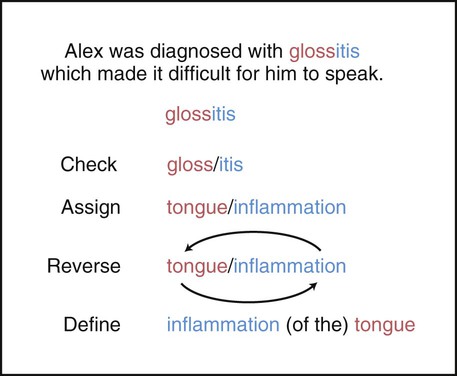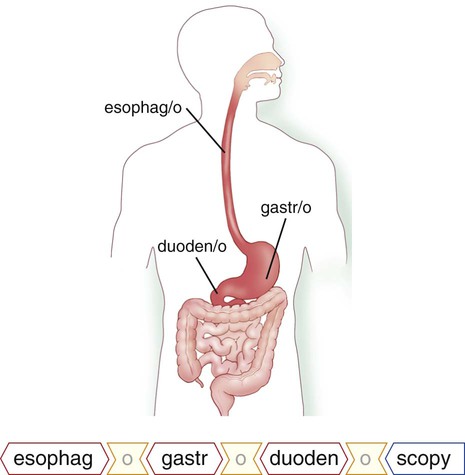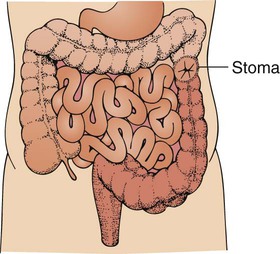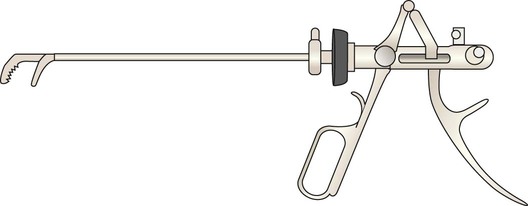Introduction to Healthcare Terminology
Derivation of Healthcare Terms
Ancient Word Origins in Current English and Healthcare Terminology Usage
| Term | Word Origins | Definition |
| glossary | gloss/o tongue (Greek) -ary pertaining to |
An English term meaning “an alphabetical list of terms with definitions.” |
| glossitis | gloss/o tongue (Greek) -itis inflammation |
A healthcare term meaning “inflammation of the tongue.” |
| bilingual | bi- two lingu/o tongue (Latin) -al pertaining to |
An English term meaning “pertaining to two languages.” |
| sublingual | sub- under lingu/o tongue (Latin) -al pertaining to |
A healthcare term meaning “pertaining to under the tongue.” |
Did you notice that healthcare terms use the word origins literally, whereas English words are related to word origins but are not exactly the same? Fortunately, most healthcare terms may be assigned a simple definition through the use of their word parts.
Types of Healthcare Terms
Decodable Terms
• Combining form: word root with its respective combining vowel.
 Combining vowel: a letter sometimes used to join word parts. Usually an “o” but occasionally an “e” or “i.”
Combining vowel: a letter sometimes used to join word parts. Usually an “o” but occasionally an “e” or “i.”
• Suffix: word part that appears at the end of a term. Suffixes are used to indicate whether the term is an anatomic, pathologic, or procedural term.
• Prefix: word part that sometimes appears at the beginning of a term. Prefixes are used to further define the absence, location, number, quantity, or state of the term.
In our first examples, gloss/ and lingu/ are word roots with an “o” as their combining vowel. Gloss/o and lingu/o are therefore combining forms; -ary, -al, and –itis are suffixes; and bi- and sub- are prefixes. Figs. 1-1 and 1-2 demonstrate the decoding of the terms glossitis and sublingual.
Nondecodable Terms
• Cataract: From the Greek term meaning “waterfall.” In healthcare language, this means “progressive loss of transparency of the lens.”
• Asthma: From the Greek term meaning “panting.” Although this word origin is understandable, the definition is “a respiratory disorder characterized by recurring episodes of paroxysmal dyspnea (difficulty breathing).”
• Diagnosis: The disease or condition that is named after a healthcare professional evaluates a patient’s signs, symptoms, and history. Although the term is built from word parts (dia-, meaning “through,” “complete”; and -gnosis, meaning “state of knowledge”), using these word parts to form the definition of diagnosis, which is “a state of complete knowledge,” really isn’t very helpful.
• Prognosis: Similar to diagnosis, the term prognosis can be broken down into its word parts (pro-, meaning “before” or “in front of”; and -gnosis, meaning “state of knowledge”), but this does not give the true definition of the term, which is “a prediction of the probable outcome of a disease or disorder.”
• Sequela: A condition that results from an injury or disease. Referred to in coding as a “late effect.”
• Acute: A term that describes an abrupt, severe onset to a disease (acu- means “sharp”).
• Chronic: Developing slowly and lasting for a long time (chron/o means “time”). Diagnoses may be additionally described as being either acute or chronic.
• Sign: An objective finding of a disease state (e.g., fever, high blood pressure, rash).
• Symptom: A subjective report of a disease (pain, itching).
• Syndrome: A group of signs and symptoms that consistently appear together.
• Etiology: Literally the “study of cause,” although the term is used in coding to simply refer to the cause of a disease.
• Manifestation: An outward demonstration or perception. Signs and symptoms are manifestations of diseases.
Other types of terms that are not built from word parts include the following:
• Eponyms: Terms that are named after a person or place associated with the term. Examples include:
 Alzheimer’s disease, which is named after Alois Alzheimer, a German neurologist. The disease is a progressive mental deterioration.
Alzheimer’s disease, which is named after Alois Alzheimer, a German neurologist. The disease is a progressive mental deterioration.
 Achilles tendon, a body part named after a figure in Greek mythology whose one weak spot was this area of his anatomy. Tendons are bands of tissue that attach muscles to bone. The Achilles tendon is the particular tendon that attaches the calf muscle to the heel bone (calcaneus). Unlike some eponyms, this one does have a medical equivalent, the calcaneal tendon.
Achilles tendon, a body part named after a figure in Greek mythology whose one weak spot was this area of his anatomy. Tendons are bands of tissue that attach muscles to bone. The Achilles tendon is the particular tendon that attaches the calf muscle to the heel bone (calcaneus). Unlike some eponyms, this one does have a medical equivalent, the calcaneal tendon.
Abbreviations and Symbols
Abbreviations are terms that have been shortened to letters and/or numbers for the sake of convenience. Symbols are graphic representations of a term. Abbreviations and symbols are extremely common in written and spoken healthcare terminology but can pose problems for healthcare workers. The Joint Commission has published a “DO NOT USE” list of dangerously confusing abbreviations, symbols, and acronyms that should be avoided (see Appendix D). The Institute of Safe Medical Practice, Inc., has provided a more extensive list. Each healthcare organization should have an official list, which includes the single meaning allowed for each abbreviation or symbol. Examples of acceptable abbreviations and symbols include the following:
• Simple abbreviations: A combination of letters (often, but not always, the first of significant word parts) and sometimes numbers
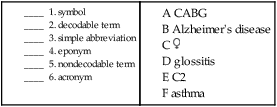
Match the nondecodable term to its definition.
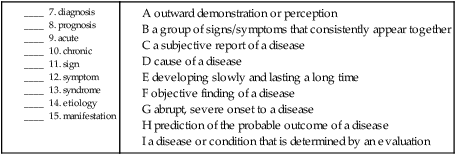
Decoding Terms
Check, Assign, Reverse, Define (CARD) Method
• Check for the word parts in a term.
• Assign meanings to the word parts.
• Reverse the meaning of the suffix to the front of your definition.
Using Fig. 1-3, see how this process is applied to your first patient, Alex.
The “wheels of terminology” included on Fig. 1-4 demonstrate how different suffixes in the table below can be added to a combining form to make a variety of terms.

Common Combining Forms and Suffixes
| Combining Forms | Suffixes |
| arthr/o = joint | -algia = pain |
| gastr/o = stomach | -tomy = cutting |
| ophthalm/o = eye | -scope = instrument to view |
| ot/o = ear | -logy = study of |
| rhin/o = nose | -plasty = surgically forming |
| hepat/o = liver | -itis = inflammation |
| Term | Word Origins | Definition |
| arthralgia | arthr/o joint -algia pain of |
Pain of a joint. Also called arthrodynia. |
| gastrotomy | gastr/o stomach -tomy cutting |
Incision of the stomach. |
| hepatitis | hepat/o liver -itis inflammation |
Inflammation of the liver. |
| ophthalmoscope | ophthalm/o eye -scope instrument to view |
Instrument used to view the eye. |
| otology | ot/o ear -logy study of |
Study of the ear. |
| rhinoplasty | rhin/o nose -plasty surgically forming |
Surgical formation of the nose. |


Building Terms
Spelling Rules
With a few exceptions, decodable healthcare terms follow five simple rules.
1. If the suffix starts with a vowel, a combining vowel is not needed to join the parts. For example, it is simple to combine the combining form arthr/o and suffix -itis to build the term arthritis, which means “an inflammation of the joints.” The combining vowel “o” is not needed because the suffix starts with the vowel “i.”
2. If the suffix starts with a consonant, a combining vowel is needed to join the two word parts. For example, when building a term using arthr/o and -plasty, the combining vowel is retained and the resulting term is spelled arthroplasty, which refers to surgically forming a joint.
3. If a combining form ends with the same vowel that begins a suffix, one of the vowels is dropped. The term that means “inflammation of the inside of the heart” is built from the suffix -itis (inflammation), the prefix endo- (inside), and the combining form cardi/o. Endo– + cardi/o + -itis would result in endocardiitis. Instead, one of the i’s is dropped, and the term is spelled endocarditis.
4. If two or more combining forms are used in a term, the combining vowel is retained between the two, regardless of whether the second combining form begins with a vowel or a consonant. For example, joining gastr/o and enter/o (small intestine) with the suffix -itis, results in the term gastroenteritis. Notice that the combining vowel is kept between the two combining forms (even though enter/o begins with the vowel “e”), and the combining vowel is dropped before the suffix -itis.
5. Sometimes when two or more combining forms are used to make a medical term, special notice must be paid to the order in which the combining forms are joined. For example, joining esophag/o (which means esophagus), gastr/o (which means stomach), and duoden/o (which means duodenum, the first part of the small intestines) with the suffix -scopy (viewing), produces the term esophagogastroduodenoscopy. An esophagogastroduodenoscopy is a viewing of the esophagus, stomach, and duodenum. In this procedure, the examination takes place in a specific sequence, that is, esophagus first, stomach second, then the duodenum. Thus the term reflects the direction in which the scope travels through the body (Fig. 1-5).
Suffixes
The body systems chapters in this text (Chapters 3 through 15) include many combining forms that are used to build terms specific to each system. These combining forms will not be seen elsewhere, except as a sign or symptom of a particular disorder. Suffixes, however, are used over and over again throughout the text. Suffixes usually can be grouped according to their purposes. The following tables cover the major categories.
Noun-Ending Suffixes
| Suffix | Meaning | Example | Word Origins | Definition |
| -icle | small, tiny | cuticle | cut/o skin -icle small |
Small skin (surrounding the nail). |
| -is | structure, thing | hypodermis | hypo- under derm/o skin -is structure |
Structure under the skin. |
| -ole | small, tiny | arteriole | arteri/o artery -ole small |
Small artery. |
| -ule | small, tiny | venule | ven/o vein -ule small |
Small vein. |
| -um | structure, thing, membrane | endocardium | endo- within cardi/o heart -um structure |
Structure within the heart. |
| -y | condition, process of | polydactyly | poly- many, much, excessive, frequent dactyl/o digitus (finger, toe) -y condition, process of |
Condition of excessive fingers or toes. |
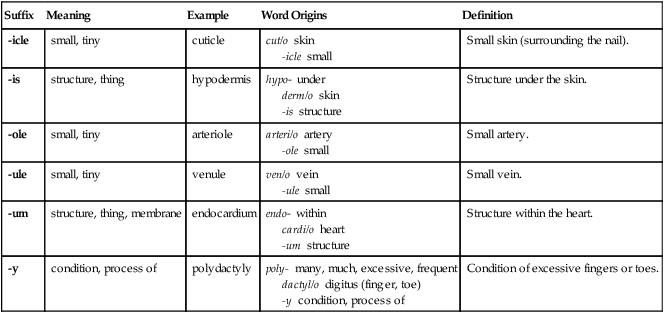
Adjective Suffixes
| Suffix | Meaning | Example | Word Origins | Definition |
| -ac | pertaining to | cardiac | cardi/o heart -ac pertaining to |
Pertaining to the heart. |
| -al | pertaining to | cervical | cervic/o neck -al pertaining to |
Pertaining to the neck. |
| -ar | pertaining to | valvular | valvul/o valve -ar pertaining to |
Pertaining to a valve. |
| -ary | pertaining to | coronary | coron/o* heart, crown -ary pertaining to |
Pertaining to the heart. |
| -eal | pertaining to | esophageal | esophag/o esophagus -eal pertaining to |
Pertaining to the esophagus. |
| -ic | pertaining to | hypodermic | hypo- below derm/o skin -ic pertaining to |
Pertaining to below the skin. |
| -ous | pertaining to | subcutaneous | sub- under cutane/o skin -ous pertaining to |
Pertaining to under the skin. |
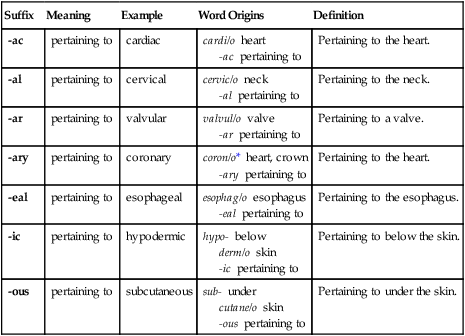
*Coron/o literally means “crown,” but is used most frequently to describe the arteries that supply blood to the heart, so the meaning “heart” has been added.
Pathology Suffixes
| Suffix | Meaning | Example | Word Origins | Definition |
| -algia | pain | cephalalgia | cephal/o head -algia pain |
Pain in the head. |
| -cele | herniation | cystocele | cyst/o bladder, sac -cele herniation, protrusion |
Herniation of the bladder. |
| -dynia | pain | cardiodynia | cardi/o heart -dynia pain |
Pain in the heart. |
| -emia | blood condition | hyperlipidemia | hyper- excessive lipid/o fats -emia blood condition |
Excessive fats in the blood. |
| -ia | condition | agastria | a- without gastr/o stomach -ia condition |
Condition of having no stomach. |
| -itis | inflammation | gastroenteritis | gastr/o stomach enter/o small intestine -itis inflammation |
Inflammation of the stomach and small intestine. |
| -malacia | softening | chondromalacia | chondr/o cartilage -malacia softening |
Softening of the cartilage. |
| -megaly | enlargement | splenomegaly (Fig. 1-6) | splen/o spleen -megaly enlargement |
Enlargement of the spleen. |
| -oma | tumor, mass | osteoma | oste/o bone -oma tumor, mass |
Tumor of a bone. |
| -osis | abnormal condition | psychosis | psych/o mind -osis abnormal condition |
Abnormal condition of the mind. |
| -pathy | disease process | gastropathy | gastr/o stomach -pathy disease process |
Disease process of the stomach. |
| -ptosis | prolapse, drooping | hysteroptosis | hyster/o uterus -ptosis prolapse, drooping |
Prolapse of the uterus. |
| -rrhage, -rrhagia | bursting forth | hemorrhage (Fig. 1-7) | hem/o blood -rrhage bursting forth |
Bursting forth of blood. |
| -rrhea | discharge, flow | otorrhea | ot/o ear -rrhea discharge, flow |
Discharge from the ear. |
| -rrhexis | rupture | cystorrhexis | cyst/o bladder, sac -rrhexis rupture |
Rupture of the bladder. |
| -sclerosis | abnormal condition of hardening | arteriosclerosis | arteri/o artery -sclerosis abnormal condition of hardening |
Abnormal condition of hardening of an artery. |
| -spasm | spasm; sudden, involuntary contraction | bronchospasm | bronch/o -spasm |
spasm of a bronchus |
| -stenosis | abnormal condition of narrowing | tracheostenosis | trache/o trachea, windpipe -stenosis abnormal condition of narrowing |
Abnormal condition of narrowing of the trachea or windpipe. |
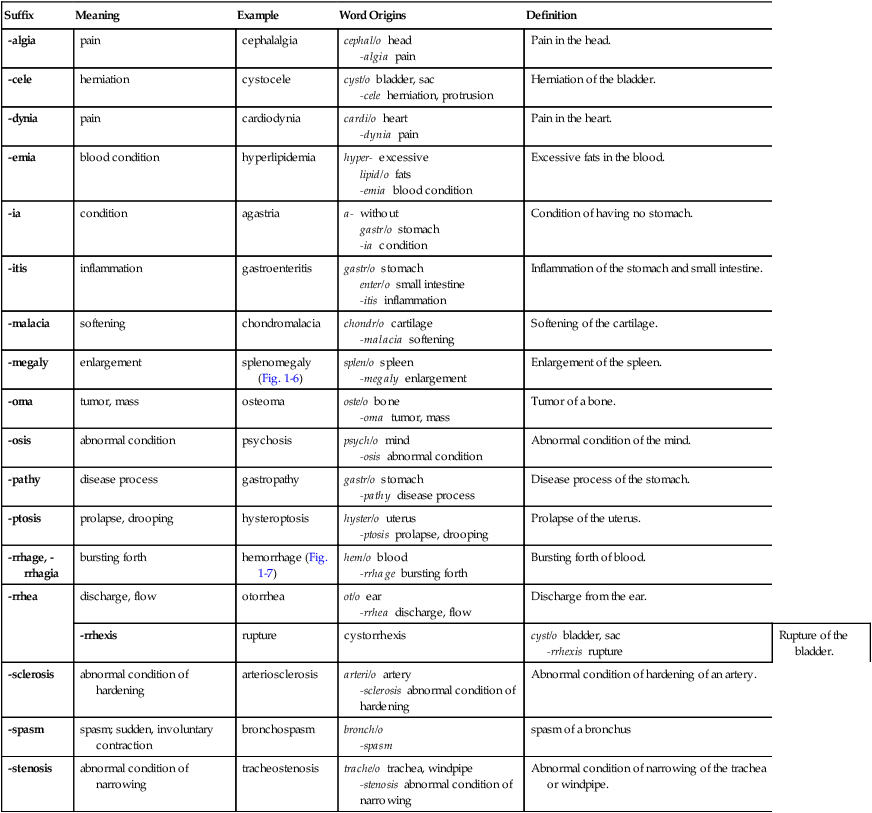

Using the method shown in Figure 1-3 and the new word parts introduced in the preceding tables, decode and define these five NEW terms.
11. cardiomegaly ___________________________________________________________________________________
12. osteomalacia ____________________________________________________________________________________
13. valvulitis _______________________________________________________________________________________
14. cephalic ________________________________________________________________________________________
15. gastroptosis _____________________________________________________________________________________
ICD-10-PCS
| Suffix | Meaning | Example | Word Origins | Definition |
| -centesis | surgical puncture | amniocentesis | amni/o amnion, inner fetal sac -centesis surgical puncture |
Surgical puncture of the inner fetal sac.* |
| -desis | binding | arthrodesis | arthr/o joint -desis binding |
Binding of a joint. |
| -ectomy | cutting out | tonsillectomy | tonsill/o tonsil -ectomy cutting out |
Cutting out the tonsils. |
| -graphy | recording | mammography | mamm/o breast -graphy recording |
Recording the breast. |
| -metry | measuring | spirometry | spir/o breathing -metry measuring |
Measuring breathing (Fig. 1-8). |
| -opsy | viewing | biopsy | bi/o living, life -opsy viewing |
Viewing living tissue. |
| -pexy | suspension, fixation | patellapexy | patell/a kneecap, patella -pexy suspension, fixation |
Suspension of the kneecap. |
| -plasty | surgically forming | rhinoplasty | rhin/o nose -plasty surgically forming |
Surgically forming the nose. |
| -rrhaphy | suturing | splenorrhaphy | splen/o spleen -rrhaphy suturing |
Suturing the spleen. |
| -scopy | viewing | esophagogastroduodenoscopy | esophag/o esophagus gastr/o stomach duoden/o duodenum -scopy viewing |
Viewing the esophagus, stomach, and duodenum. |
| -stomy | making a new opening | colostomy | col/o colon, large intestine -stomy making a new opening |
Making a new opening in the colon or large intestine (Fig. 1-9). |
| -tomy | cutting | osteotomy | oste/o bone -tomy cutting |
Incision into the bone. |
| -tripsy | crushing | lithotripsy | lith/o stone -tripsy crushing |
Crushing of stones. |
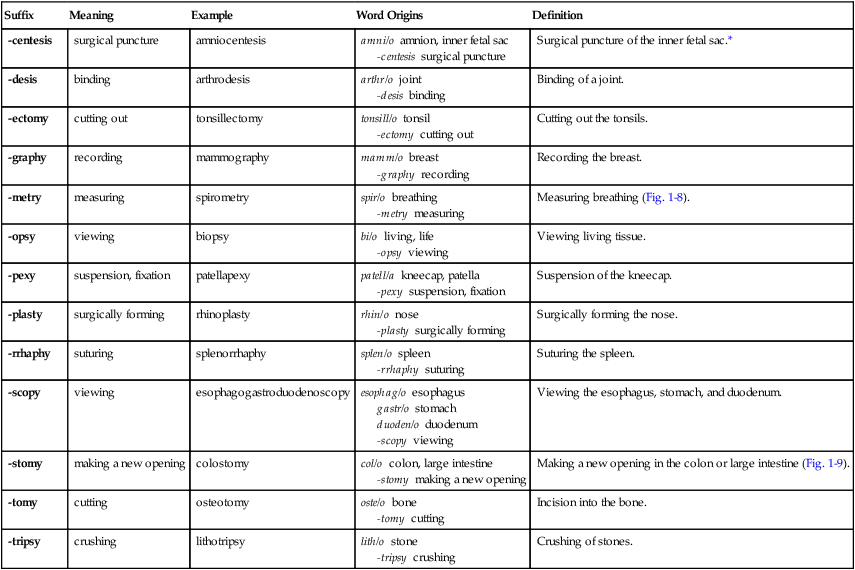
*Please note that these simple definitions are used to demonstrate the value of learning the Greek and Latin word parts for decodable terms. The definitions in the body system chapters are more robust.
Instrument Suffixes
| Suffix | Meaning | Example | Word Origins | Definition |
| -graph | instrument to record | electrocardiograph | electr/o electricity cardi/o heart -graph instrument to record |
Instrument to record the electricity of the heart. |
| -meter | instrument to measure | thermometer | therm/o temperature, heat -meter instrument to measure |
Instrument to measure temperature. |
| -scope | instrument to view | ophthalmoscope | ophthalm/o eye -scope instrument to view |
Instrument to view the eye. |
| -tome | instrument to cut | osteotome | oste/o bone -tome instrument to cut |
Instrument to cut bone (Fig. 1-10). |
| -tripter | machine to crush | lithotripter | lith/o stone -tripter machine to crush |
Machine to crush stone. |
| -trite | instrument to crush | lithotrite | lith/o stone -trite instrument to crush |
Instrument to crush stones (Fig. 1-11). |
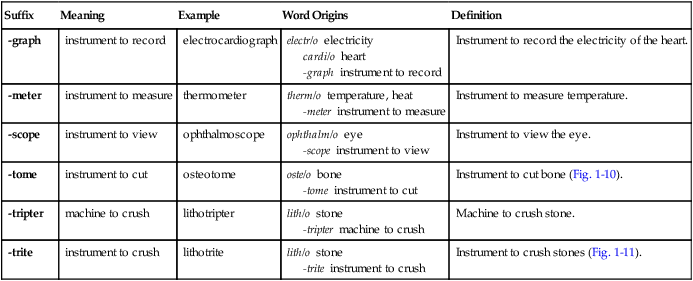
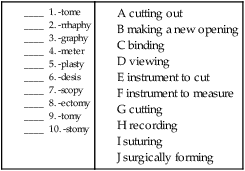
Using the method shown in Figure 1-3 and the new word parts introduced in the preceding tables, decode and define these five NEW terms.
11. arthrocentesis ___________________________________________________________________________________
12. spirometer ______________________________________________________________________________________
13. hysteroscopy ____________________________________________________________________________________
14. cystoscope ______________________________________________________________________________________
15. splenectomy ____________________________________________________________________________________
Prefixes
Prefixes modify a medical term by indicating a structure’s or a condition’s:
Sometimes, as with other word parts, a prefix can have one or more meanings. For example, the prefix hypo- can mean “below” or “deficient.”
| Prefix | Meaning | Example | Word Origins | Definition |
| a- | no, not, without | apneic | a- no, not, without pne/o breathing -ic pertaining to |
Pertaining to without breathing. |
| an- | no, not, without | anophthalmia | an- without ophthalm/o eye -ia condition |
Condition of without an eye. |
| ante- | forward, in front of, before | anteversion | ante- forward vers/o turning -ion process of |
Process of turning forward. |
| anti- | against | antibacterial | anti- against bacteri/o bacteria -al pertaining to |
Pertaining to against bacteria. |
| dys- | abnormal, difficult, bad, painful | dystrophy | dys- abnormal -trophy process of nourishment |
Process of abnormal nourishment. |
| endo-, end- | within | endoscopy | endo- within -scopy viewing |
Viewing within. |
| epi- | above, upon | epigastric | epi- above gastr/o stomach -ic pertaining to |
Pertaining to above the stomach. |
| hyper- | excessive, above | hyperglycemia | hyper- excessive, above glyc/o sugar, glucose -emia blood condition |
Blood condition of excessive sugar. |
| hypo- | below, deficient | hypoglossal | hypo- below gloss/o tongue -al pertaining to |
Pertaining to below the tongue. |
| inter- | between | intervertebral | inter- between vertebr/o vertebra, backbone -al pertaining to |
Pertaining to between the backbones. |
| intra- | within | intramuscular | intra- within muscul/o muscle -ar pertaining to |
Pertaining to within the muscle. |
| neo- | new | neonatal | neo- new nat/o birth, born -al pertaining to |
Pertaining to a newborn. |
| par- | near, beside | parotid | par- near ot/o ear -id pertaining to |
Pertaining to near the ear. |
| para- | near, beside, abnormal | paraphilia | para- abnormal phil/o attraction -ia condition |
Condition of abnormal attraction. |
| per- | through | percutaneous | per- through cutane/o skin -ous pertaining to |
Pertaining to through the skin (Fig. 1-12). |
| peri- | surrounding, around | pericardium | peri- surrounding cardi/o heart -um structure |
Structure surrounding the heart. |
| poly- | many, much, excessive, frequent | polyneuritis | poly- many, much, excessive, frequent neur/o nerve -itis inflammation |
Inflammation of many nerves. |
| post- | after, behind | postnatal | post- after, behind nat/o birth, born -al pertaining to |
Pertaining to after birth. |
| pre- | before, in front of | prenatal | pre- before nat/o birth, born -al pertaining to |
Pertaining to before birth. |
| sub- | under, below | subhepatic | sub- under hepat/o liver -ic pertaining to |
Pertaining to under the liver. |
| trans- | through, across | transurethral | trans- through urethr/o urethra -al pertaining to |
Pertaining to through the urethra. |
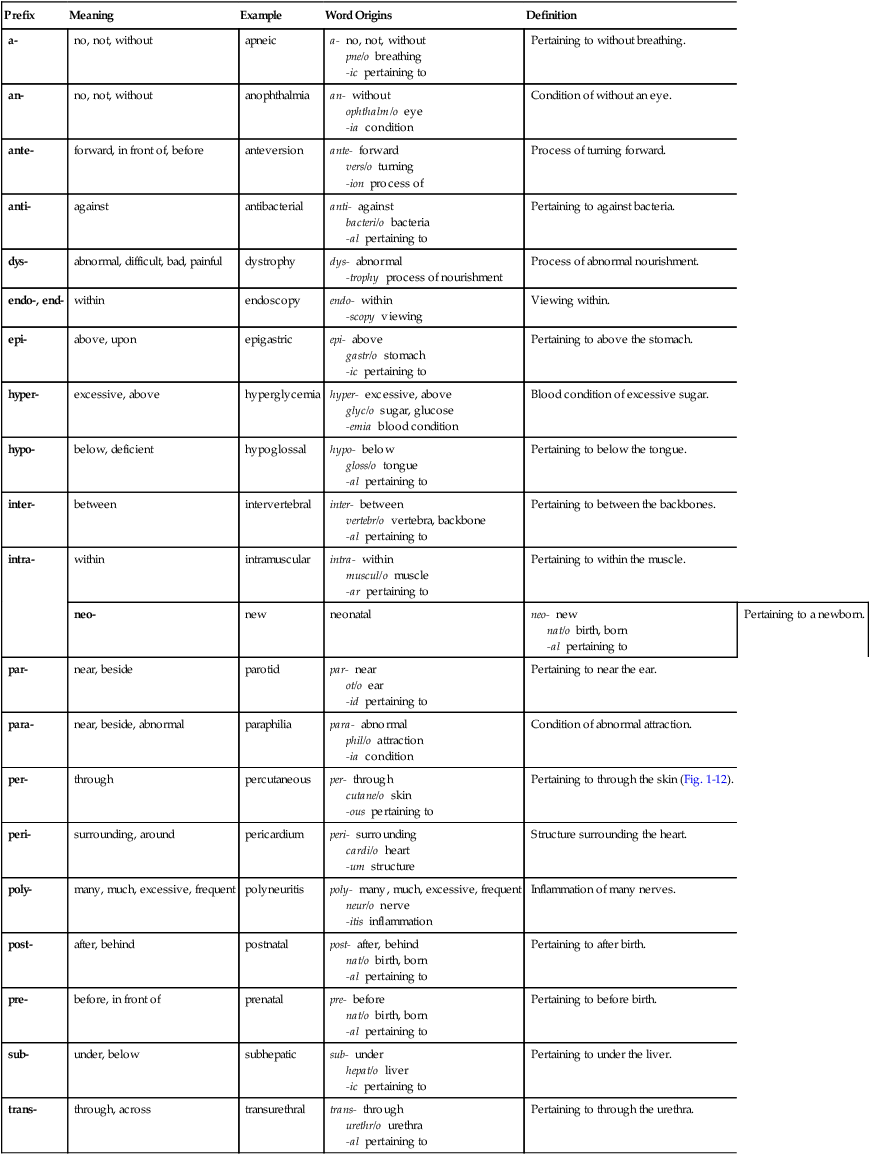
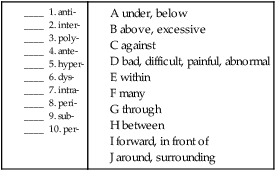
Using the method shown in Figure 1-3 and the new word parts introduced in the preceding tables, decode and define these five terms.
11. subhepatic ______________________________________________________________________________________
12. pericardium _____________________________________________________________________________________
13. dyspneic ________________________________________________________________________________________
14. percutaneous ____________________________________________________________________________________
15. hypoglycemia ___________________________________________________________________________________
Singular/Plural Rules
Rules for Using Singular and Plural Endings
| If a Term Ends in: | Form the Plural by: | Singular Example | Plural Example | Plural Pronounced as: |
| -a | dropping the -a and adding -ae | vertebra (a bone in the spine) | vertebrae | Long a, e, or i, depending on the term |
| -is | dropping the -is and adding -es | arthrosis (an abnormal condition of a joint) | arthroses | seez |
| -ix or -ex | dropping the -ix or -ex and adding -ices | appendix | appendices | seez |
| -itis | dropping the -itis and adding -itides | arthritis (inflammation of a joint) | arthritides | deez |
| -nx | dropping the -nx and adding -nges | phalanx (a bone in the fingers or toes) | phalanges | ng (as in sing) and jeez |
| -um | dropping the -um and adding an -a | endocardium (the structure inside the heart) | endocardia | ah |
| -us | dropping the -us and adding an -i | digitus (a finger or toe) | digiti | eye |
| -y | dropping the -y and adding -ies | therapy (a treatment) | therapies | eez |

| Combining Form | Meaning |
| arteri/o | artery |
| arthr/o | joint |
| bacteri/o | bacteria |
| bi/o | living, life |
| cardi/o | heart |
| cephal/o | head |
| cervic/o | neck, cervix |
| chondr/o | cartilage |
| col/o | large intestine, colon |
| coron/o | crown, heart |
| cut/o | skin |
| cutane/o | skin |
| cyst/o | bladder, sac |
| dent/i | tooth |
| derm/o | skin |
| duoden/o | duodenum |
| electr/o | electricity |
| enter/o | small intestine |
| esophag/o | esophagus |
| gastr/o | stomach |
| gloss/o | tongue |
| glyc/o | glucose, sugar |
| hem/o | blood |
| hepat/o | liver |
| hyster/o | uterus |
| lingu/o | tongue |
| lipid/o | lipid, fat |
| lith/o | stone |
| mamm/o | breast |
| muscul/o | muscle |
| my/o | muscle |
| nat/o | birth, born |
| neur/o | nerve |
| ophthalm/o | eye |
| oste/o | bone |
| ot/o | ear |
| path/o | disease |
| ped/o | child |
| phil/o | attraction |
| pne/o | breathing |
| psych/o | mind |
| rhin/o | nose |
| somn/o | sleep |
| spir/o | breathing |
| splen/o | spleen |
| therm/o | heat, temperature |
| tonsill/o | tonsil |
| trache/o | trachea, windpipe |
| troph/o | nourishment, development |
| urethr/o | urethra |
| valvul/o | valve |
| ven/o | vein |
| vers/o | turning |
| vertebr/o | backbone, vertebra |






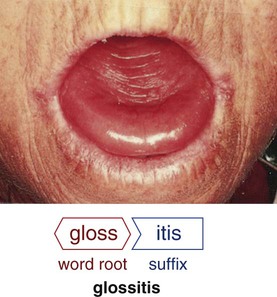
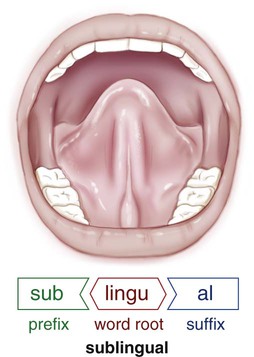




 stands for female
stands for female stands for male
stands for male
